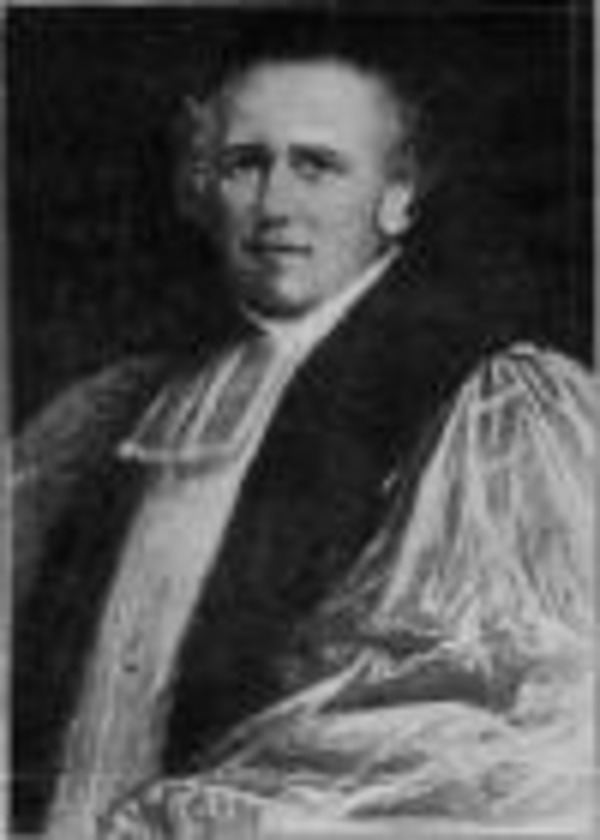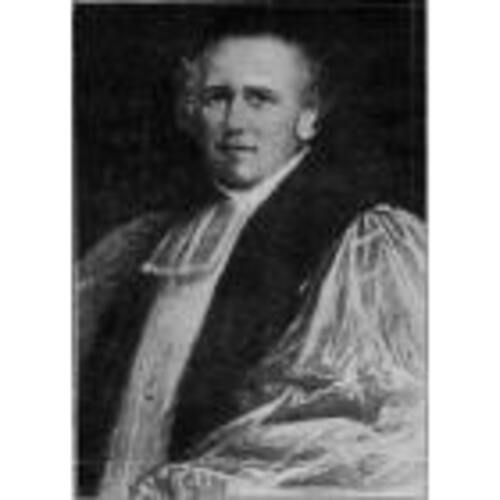
Source: Link
STANSER, ROBERT, Church of England clergyman and bishop; b. 16 March 1760, probably in Harthill, Yorkshire, England (the place of his baptism), son of the Reverend Robert Stanser and Sarah Stanser; he and his wife Mary had at least eight children; d. 23 Dec. 1828 in Hampton, England.
Educated at St John’s College, Cambridge, Robert Stanser was ordained deacon in 1783 and priest in 1784 and appointed his father’s curate at Bulwell in Nottinghamshire. For several years before being recruited for service in Nova Scotia, he worked in the home department of the Society for the Propagation of the Gospel. In 1791 he was appointed by the SPG as clergyman at St Paul’s Church in Halifax where the congregation had a reputation for acting independently, even in the choice of their rector. Fortunately for Stanser, the congregation was more interested in thwarting Lieutenant Governor John Parr*’s highly prized prerogative in church matters, especially his claim to the patronage of the parish, than in promoting a particular candidate for the position. In the autumn of 1791, a few months after arriving in Halifax, Stanser was inducted as the rector of St Paul’s.
Stanser remained rector of St Paul’s for the next 25 years, although he did return to England frequently on leaves of absence. As rector, he established a good rapport with the parishioners, his superiors, and the wider Halifax community. Despite later criticisms that he was a laborious and monotonous preacher, Stanser succeeded in satisfying his fastidious flock – known for its evangelical leanings and strong commitment to congregational independence – and impressing Bishop Charles Inglis* with his diligence and engaging manners. He also maintained cordial relations with the non-Anglican ministers in the capital. He unabashedly sold to the clergy of dissenting denominations the marriage licences issued to him by the provincial secretary; this practice, which allowed dissenting clergy to perform nuptials for their own church members, was criticized in 1800 but quietly condoned thereafter. When in 1804 he engaged in a doctrinal disputation with Edmund Burke*, the Roman Catholic vicar general, his purpose was theological, not political. Since he had not been affected by the American revolution and lived through the period of the French revolution in the midst of a congenial multi-confessional society, he did not reach the conclusion favoured by Church of England extremists that non-Anglicans were disloyal subjects. As for Burke, he certainly held no grudges. Several years after the pamphlet debate, which had ranged Burke against Stanser and William Cochran of King’s College, the Roman Catholic leader expressed his support for Stanser’s elevation to the bishopric of Nova Scotia. Another example of Stanser’s moderation was his approval of Walter Bromley*’s nonsectarian Royal Acadian School as a resort for the poor, especially the town’s blacks who had until 1813 been taught correct religious principles and deferential social behaviour in the Bray charity school which Stanser supervised. Untypically, therefore, Stanser remained a non-controversial figure in a church and society poised on the brink of serious interdenominational disruption. His successful labours were recognized by the award of a Lambeth dd in 1806 during a visit to England.
Like other colonial clergy during the years of wartime inflation, Stanser was greatly concerned about his income. His small SPG stipend of £30 reflected the assumption that he would receive the same sufficiency of pew rents and local perquisites enjoyed by his predecessor, John Breynton*. But as a newcomer forced to compete for favours with grasping loyalist clergymen from the former American colonies, Stanser was unable to secure the same range of chaplaincies and deputy chaplaincies that had earlier belonged to the rector of the parish, although in 1793 he was made chaplain to Lieutenant Governor John Wentworth*’s new Royal Nova Scotia Regiment. No wonder, then, that he had to resort to the sale of marriage licences to his fellow clergymen. After 1800 his financial position improved as a result of an increase in his SPG stipend to £70 in 1799, the acquisition of chaplaincy appointments to the House of Assembly, Council, and two naval vessels between 1796 and 1802, and the sale in 1807 of his estate on the west side of Bedford Basin to Supreme Court judge Brenton Halliburton*.
As clergyman of the senior church in the diocese and as a popular local figure, Stanser became identified as the people’s choice for the next bishop as early as 1812 when Inglis unsuccessfully petitioned the British government for the appointment of his son John* as suffragan. Learning of the campaign to promote Stanser’s claim to the position, the bishop declared that “Stanser is a good parish priest, but his tameness, pliancy and want of firmness, to say nothing more, unfit him for the arduous office of a Bishop in this country at this most critical period.” But in 1813 Stanser could demonstrate to Colonial Secretary Lord Bathurst that his candidacy was supported by an impressive cross-section of Halifax society, including the assembly, Council, and Halifax magistracy, the wardens and vestry of St Paul’s, his colleague and former curate the Reverend George Wright* of St George’s Church (with whom he had earlier quarrelled over chaplaincies and marriage licences), nearly 200 parishioners, and the leaders of the Roman Catholic, Church of Scotland, Methodist, Baptist, and Presbyterian secessionist churches in Halifax. The bishop, concerned about his son’s future, continued to press John’s claims to the bishopric, but to no avail. When Stanser was named bishop after Charles Inglis’s death in February 1816, his success was interpreted as a triumph for broadly based colonial desires. The preferences of the people, however, were not the only consideration. Equally important were the objections of the British authorities to overt nepotism and the lack of any other acceptable candidates. Lieutenant Governor Sir John Coape Sherbrooke concluded that Stanser “had the best claims and would be the most popular choice” only after he had strongly stated his preference for an outsider from England who would have enough “coolness, moderation and good sense to sooth and conciliate rather than irritate and disgust the dissenters which might disturb the peace of the country.”
In the event the contest over the succession was rendered a pointless exercise. Stanser, consecrated bishop at Lambeth Palace on 19 May 1816, was back in Halifax by that August. For reasons of health, he returned to England late in 1817 and there he remained, keeping contact with his diocese through attendance at SPG meetings and occasional conferences with the new rector of St Paul’s, John Inglis, on the latter’s visits to England. Stanser held on to his sinecure until December 1824, when satisfactory financial arrangements were finally made for his retirement in the form of a £250 pension. In the mean time Inglis became, in his continuing position as ecclesiastical commissary, bishop in fact though not in name. His eventual appointment as bishop in 1825 was accompanied by another succession crisis at St Paul’s, this one involving the Reverend John Thomas Twining*, against which the 1791 dispute paled in comparison. By the time of Stanser’s death in 1828 non-Anglican Nova Scotians, as well as evangelical Anglican ones, had gained sufficient experience of John Inglis’s heavy-handed, uncompromising character as a church leader to opine in their eulogies for Stanser: “Happy would it have been for the interests of all religious parties in Nova-Scotia, if Providence had prolonged his existence, and allowed him to continue his labours among us.”
Robert Stanser is the author of A sermon, preached before the honorable House of Assembly, of the province of Nova-Scotia, in the parish church of St. Paul in Halifax, on Sunday, March 16th, 1800 (Halifax, [1800]) and An examination of the Reverend Mr. Burke’s “Letter of instruction, to the Catholic missionaries of Nova-Scotia, and its dependencies”; addressed to Christians of every denomination (Halifax, 1804).
Lambeth Palace Library (London), SPG papers, XI, nos.41, 48–49, 50–53, 61, 63, 69–70. PAC, MG 24, A57, 1–2 (mfm.); B16. PANS, Biog., Charles Inglis, letter-books, 24–25 (mfm.); MG 1, 747, no.28; RG 1, 59, doc.88 (transcript); 63, doc.29. PRO, CO 217/89: 194; 217/90: 218–19; 217/91: 84–88; 217/92: 87–88, 135–36; 217/98: 10–15; 217/143: 79, 81–82, 333–34; CO 226/29: 96. St Paul’s Anglican Church (Halifax), Reg. of baptisms, marriages, and burials, 1791–1816 (mfm. at PANS). SRO, GD45/3/552, no.46 (mfm. at PAC). USPG, C/CAN/NS, 2, nos.20–34; Dr. Bray’s Associates, unbound papers, box 7; Journal of SPG, 25–35. Acadian Recorder, 5 Oct. 1816, 7 March 1829. Colonial Patriot (Pictou, N.S.), 18 March 1829. Alumni Cantabrigienses . . . , comp. John and J. A. Venn (2 pts. in 10v., Cambridge, Eng., 1922–54), pt.ii, 6. Susan Buggey, “Churchmen and dissenters: religious toleration in Nova Scotia, 1758–1835” (ma thesis, Dalhousie Univ., Halifax, 1981). Judith Fingard, The Anglican design in loyalist Nova Scotia, 1783–1816 (London, 1972); “The Church of England in British North America, 1787–1825” (phd thesis, Univ. of London, 1970). R. V. Harris, The Church of Saint Paul in Halifax, Nova Scotia: 1749–1949 (Toronto, 1949). Pascoe, S.P.G. J. [E.] Tulloch, “Conservative opinion in Nova Scotia during an age of revolution, 1789–1815” (ma thesis, Dalhousie Univ., 1972). G. W. Hill, “History of St. Paul’s Church,” N.S. Hist. Soc., Coll., 1 (1879): 35–58; 2 (1881): 63–99; 3 (1883): 13–70. C. E. Thomas, “Robert Stanser, 1760–1828,” N.S. Hist. Soc., Coll., 35 (1966): 1–27.
Cite This Article
Judith Fingard, “STANSER, ROBERT,” in Dictionary of Canadian Biography, vol. 6, University of Toronto/Université Laval, 2003–, accessed December 30, 2025, https://www.biographi.ca/en/bio/stanser_robert_6E.html.
The citation above shows the format for footnotes and endnotes according to the Chicago manual of style (16th edition). Information to be used in other citation formats:
| Permalink: | https://www.biographi.ca/en/bio/stanser_robert_6E.html |
| Author of Article: | Judith Fingard |
| Title of Article: | STANSER, ROBERT |
| Publication Name: | Dictionary of Canadian Biography, vol. 6 |
| Publisher: | University of Toronto/Université Laval |
| Year of publication: | 1987 |
| Year of revision: | 1987 |
| Access Date: | December 30, 2025 |



